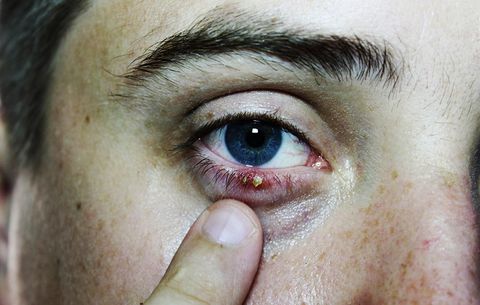What is a stye on the eye?
A very common minor eye condition is a stye. The medical word for stye is hordeolum and they can be divided into two kinds: internal and external. Another condition that is often confused as a stye is a chalazion. All three conditions will be discussed below.
The most important difference between and internal and external hordeolum is the location. An external hordeolum is an infection of a gland around the follicle of an eyelash. This is what is most commonly thought of as a style. On the other hand, an internal hordeolum is the infection of one or more meibomian glands, which are deeper or more internal into the eyelid.
Styes, both internal and external, are active infections causing swelling and inflammation. Usually they are red, tender bump on the eyelid. An external hordeolum can be like a pimple with a visible head of pus in the center. They can feel scratchy.
A chalazion is not an active infection but rather a clogged oil gland in which the oil is thickened up and starting to solidify (turning into a granuloma). Because they are not actively infected, chalazion are usually not tender and are not very red. You may still feel a small to moderate size lump within your eyelid. If a chalazion gets large and firm it can cause blurred vision by distorting the cornea.

In all of these conditions, the cause of the problem is often the glands getting blocked up. Conditions like blepharitis, meibomian gland dysfunction and ocular rosacea allow bacteria to grow on the eyelid and create a biofilm along the edge of the eyelid which covers the pores of the oil secreting glands. When the glands are blocked the oil stagnates and thickens up, usually causing dry eyes and irritation. If the blockage continues the glands get infected and causes a stye.
How to treat a stye
Styes may respond on their own, but actively treating it can speed the resolution significantly. If you wait too long to treat the hordeolum it is more likely to convert to a chalazion, which is less likely to respond the simple treatments. Here are the most common way to treat styes (often multiple treatments are done at the same time):.
- Warm, moist heat is the mainstay of hordeolum treatment. At home you can apply a washcloth soaked in warm water to the eyelid for 15 minutes 2-4 times per day (the more the better). The washcloth will cool off quickly so you will need to reheat it every few minutes. A better alternative is the Bruder Moist Heat Eye Compress since you only heat it in the microwave once to provide 15 minutes of heat treatment.
- Miboflo – This is an in-office treatment that is like a medical grade warm compress. Heat is massaged into the eyes and the massaging action helps unclog the glands naturally. As a bonus your eyes will feel better and less dry.
- Oral antibiotics treat the active infection thereby reducing the swelling and pain. Usually 1-2 tabs per day for 10 days.
- Lid scrubs such as Ocusoft Original Lid Scrubs Keeps are used to clean the biofilm off the eyelids and keeps the pores open.
- Steroid injections can be used to reduce the bump, but not during the active infection/inflammatory phase of the condition.
- Excision and removal is a simple surgery in the doctor’s office but this is also not recommended during the active infection phase. Used to remove the inactive bump (chalazion) when all other treatments exhausted.
Can styes be prevented?
Once you’ve had a stye on your eye or chalazion you are at risk to experience further episodes. The good news is that a little homework on your part can help reduce the risk.
Optometrists are starting to agree that we need to take care of our eyes like we do with our teeth. You already know how important it is to brush your teeth every day to prevent cavities. Similarly, you should be cleaning your eyelids with scrubs like Ocusoft Original Lid Scrub every day to prevent conditions like blepharitis, dry eyes and styes. Also, if you have been told you have ocular rosacea you should be cleaning your lids daily with a scrub called Hypochlor.
Styes and chalazion generally respond well to treatment, but they tend to reoccur. Preventative treatment with daily eyelid scrubs helps. If you keep getting styes in the same location, your doctor may suggest a biopsy to rule out more serious problems. Don’t try to squeeze a stye to get pus to come out. This can spread the infection further into the eyelid. If it spontaneously drains then you can use some mild eyelid wipes to remove the pus and clean the affected area. Hypochlorous acid solutions are excellent for this. If you haven’t seen a doctor and the stye is not healed with a month you should definitely get it evaluated by an eye doctor.

